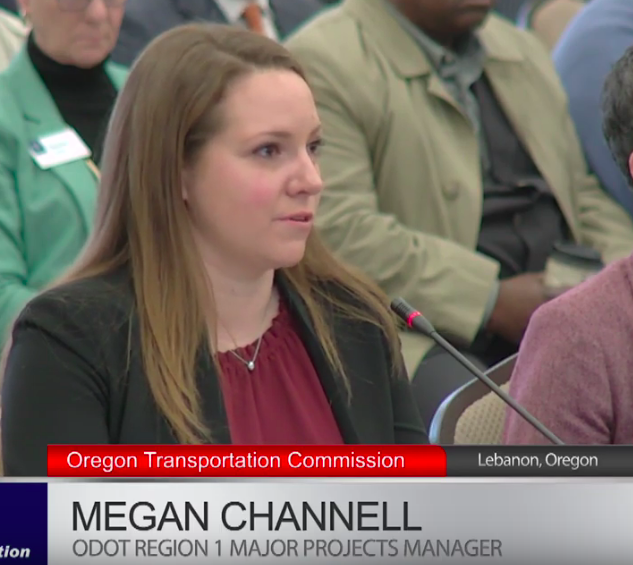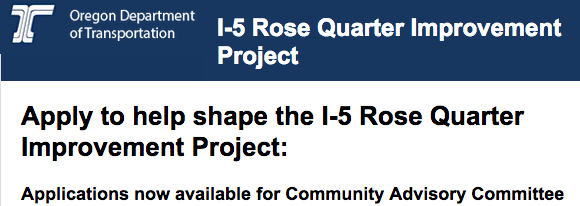ODOT doesn’t want to hear the questions its Community Advisory Committee raises about the proposed $800 million Rose Quarter Freeway widening project–so it fires them.
Agency staff misrepresent public testimony to public officials, minimizing objections, and failing to report substantive critiques of agency errors.
An ever-shifting set process with constantly changing committees lacks legitimacy.
As regular City Observatory readers will know, we’ve been closely following plans by the Oregon Department of Transportation to spend $800 million to widen a mile-long stretch of Interstate 5 through North Portland near the Rose Quarter. There’s been extraordinary and widespread community opposition.
In an effort to ameliorate the community critique, last year the agency settled on appointing a Community Advisory Committee for the project. Ostensibly, the committee’s role was to offer ODOT advise about the project, but as is now clearly the case, ODOT didn’t actually want to get any advice from the community. That’s been apparent for a couple of months now, since one key group, the Albina Vision Trust, walked away from the project, triggering an avalanche of defections from local political officials. After working with ODOT for two years, the organization gave up in frustration over ODOT’s intransigence, as its Director, Winta Yohannes told Willamette Week:
What we never got from ODOT was a willingness to explore with us what is worth having for a half a billion to a billion dollar investment. . . . it’s a comprehensive issue about the Department of Transportation once again looking at our communities as one that they can run through without considering the people and communities that exist around it today and in the future.
Last week, ODOT took the unusual step of firing the Community Advisory Committee, which had, in its first few meetings, held on-line due to pandemic restrictions, raised serious questions about the project, and challenged ODOT’s efforts to muzzle the Committee. As Bike Portland’s Jonathan Maus reported:
The Oregon Department of Transportation (ODOT) has just taken the rare step of closing down its own advisory committee in favor of a new one that will consist of mostly hand-picked members. It’s the latest twist in ODOT’s effort to resuscitate the highly controversial, $800 million I-5 Rose Quarter mega-project that’s been on life support for months.
While ODOT says the move is an effort, “To intentionally center voices of the Black community,” it also allows them to avoid difficult questions from skeptical and frustrated committee members, one of whom had already resigned and several others who planned to follow suit.
Turning a deaf ear to the community is a long tradition at ODOT.
In theory, public involvement ought to be a vehicle for assuring that major projects move forward with a full and fair understanding of all public views. Soliciting input from the public in meetings and forums should provide decision-makers with more complete information to make better decisions.
But in practice, the process has become weaponized by bureaucrats who’ve already decided what they want to do. Public involvement becomes a process for exhausting and outlasting those with legitimate concerns, and then falsely presenting a sanitized simulacrum of consent. And if, as a last resort, your selected advisory committee doesn’t roll over and agree with you, you simply fire them.
Hiding and minimizing public objections and expert technical commentary
The periodic reorganization of the public involvement process allows ODOT staff to simply “disappear” the negative comments made in previous phases of the process, and start a new conversation, controlled by ODOT staff. As the Rose Quarter project has developed, the agency has had several different advisory committees. In 2019, it put out an Environmental Assessment, and under pressure from opponents, held a public hearing to receive comments, which were overwhelmingly negative.
As was apparent from the experience of the community advisory committee, ODOT staff use their control over the agenda to block difficult questions and minimize or squelch dissenting opinions. But ODOT uses the same tactic to spoon feed its nominal overseers, the Oregon Transportation Commission, a distorted picture of public opinion about the project.
In her December 17, 2019 presentation to the Oregon Transportation Commission, Project manager Megan Channell summarized the entirety of the public comment on the $800 million Rose Quarter Freeway widening project as touching on just three issues: climate, noise and air quality:
I would say there’s three key areas where the community has had significant interest, being air quality, climate change and noise.I’ll also note that under our current administration, there’s an executive order that actually does not require climate change and greenhouse gas evaluations as part of NEPA evaluations, but given the interest and importance of that in our community and our state we were of course taking that on as part of this environmental assessment.So again, the air quality, these three, along with all the other topics again followed federal processes and most current modeling tools to come up with the evaluation and the findings. In those found that the project, the build alternative, would not result in an increase of air pollutants or greenhouse gas emissions. It would also not result in noise. . an increase in noise that would be perceptible to the human ear. When you look specifically at Harriet Tubman Middle School, which is adjacent to the project area, relative to noise, the project does, despite the increased noise not being perceptible, the project does recommend a sound wall in that area to mitigate existing noise levels . . .
What Channell left out of her presentation to the Oregon Transportation Commission was the fact there had been an outpouring of more than 2,000 comments on the project, with 90 percent opposed. She also left out that the grounds for opposition included a far wider array of issues. Instead, ODOT portrayed the comments as minor disagreements about implementation, rather than outright and detailed opposition, much of which disproved the supposed traffic and safety rationales that the agency advanced to sell the project.
And for the record, this isn’t about “sour grapes” for those who had contrary opinions: nor is it about ODOT bowing to the wishes of every commenter. The issue hear is that ODOT staff, having heard the objections from the community, fails to relay them on to decision-makers, and instead, paints a false picture of widespread support and only modest disagreement with the overall scope of the project.
One example: Steve Bozzone, Boise neighborhood
ODOT has had public involvement activities in this project for a decade. One Boise neighborhood resident, Steve Bozzone has been a member of the project’s earlier public involvement committee since 2012. Here’s were his comments to ODOT’s environmental assessment in 2019:
ODOT failed to consider HOT lanes, HOV lanes, tolling, or pro rated/pro tem highway ramps as design options for this project. During the public design process many proposals were submitted by participants that included these concepts. ODOT dismissed all alternative design concepts without any explanation for why they were unacceptable by ODOT’s standards. Those alternative concepts all lead to less surface, soil and environmental impacts.The alternative proposals all cost less funding and disruption to local air quality and pollution. They also mitigate the surface level neighborhood congestion created by the highway’s location in the heart of central Portland. Those concepts deserve to be adequately considered and not thrown out at ODOT’s whim. Attached to my comment I am submit into the record the attached previously submitted letter containing earlier expressed concerns from 2012, which ODOT has never addressed or responded to.
How ODOT manipulated its public involvement committees
In an effort to evade and bury these criticisms, in January, 2020, ODOT set about creating yet another advisory group, (the one fired this month). ODOT is solicited the community for members, sending out emails and a neighborhood mailer, calling for volunteers.
The project team has heard from the community about the importance of continued public engagement. The CAC is one example of how the project will intentionally seek community input, further extend opportunities for the public to engage, and bring community interests and values into the decision-making process. As the project moves forward, ODOT will demonstrate and communicate how the CAC’s input meaningfully informs project decisions.
We will expect you to sit through endless hours of meetings, and we will dictate the content of these meetings, and exclude or limit positions that differ from those of the Department of Transportation. No matter what you say, we will treat your participation as an endorsement of whatever we choose to do, and the fact of your attendance will be used as evidence of public support for our position. If you say anything critical or negative of about the project, you will be ignored, and it will not appear in the written reports or summaries of public involvement.
The group ended up having three meetings, all on-line, thanks to pandemic restrictions. But from the outset, members of the committee challenged ODOT’s efforts to limit the scope of their oversight, and raised numerous, and apparently, uncomfortable questions about the project. And rather than answer, ODOT chose to simply disband the group for asking questions that the agency didn’t like.
ODOT has delegitimized its entire public involvement process. It should be apparent to everyone that the advisory committee’s only purpose is to agree with ODOT; if it doesn’t do so it will be ignored, fired, and replaced.
Crushing real public input is a long standing practice
Twisting public involvement to manufacture consent is a well-established practice at the Oregon Department of Transportation. Bike Portland’s Jonathan Maus summarized years of experience with the agency in his article “You can tell ODOT what to do with their I-5 Rose Quarter Project on New Advisory Committee.”
ODOT ends up using the time and ideas of committee members while using their involvement to move the project along, check a box for the OTC [Oregon Transportation Commission], and create a narrative that everyone involved has locked arms in support of the project.
That’s what they did to push their controversial Columbia River Crossing project. In 2009, a Bicycle Transportation Alliance (now The Street Trust) staffer was a member of a CRC advisory committee. When a key decision was on the table, a disgusted BTA rep had seen enough. “The BTA is done with this public involvement theater,” said Michelle Poyourow, before leaving the committee. “We’re not going to play this game any more.”
Unfortunately, ODOT is still playing this game.
Editor’s Note: We’ve borrowed the title for this commentary from Edward Herman and Noam Chomsky’s 1988 book on the political economy of the mass media. Unfortunately, the public relations profession seems to have treated this work as a guidebook, rather than a cautionary tale.


